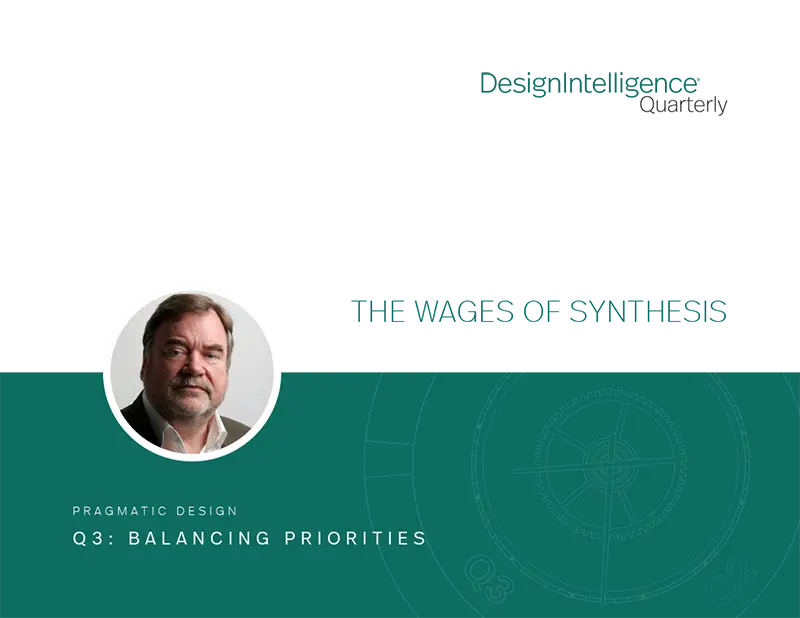The Wages of Synthesis
by Paul Finch
Programme Director,
World Architecture Festival
August 2, 2023
Paul Finch examines the architect’s duties and responsibilities to a continuum of client types
Exactly what are the duties, responsibilities and liabilities of the architect/engineer/designer? And, perhaps more importantly, exactly to whom do they apply?
This is a complicated question and one reason why design and construction are a matter of interest to lawyers. But it is a question that involves more than the letter of the law, since it may also concern ethical and moral issues, which, if you are lucky, will not arise over the course of a professional career. On the other hand ...
One conventional answer embracing all the above is that the architect’s first duty is to the client. After all, it is the client who pays the fee and sets or agrees to the programme. If you don’t like that programme, then walk away. If you undertake it, the implication is you are happy with what is being proposed.
This is why various practices decline to work, for example, on prisons, nuclear power stations or houses for very rich people. Sometimes this extends to avoiding work for particular countries or political/religious regimes. In a free country you are free to pick and choose.
Does having chosen to work for a particular client on a specific project constitute the end of the story? Not really, for a variety of reasons. First come the demands of your professional institution, organisation or registration board. These generally refer to obligations to wider society rather than simply the person or organisation paying your fee. Such obligations may be quite specific or more general, especially with regard to the environmental implications of what it is you are designing.
These are not contractual obligations as such, but they raise a fundamental point about the relationship between designers and what might be described as the “real” client for the outcome of a project. That client is, of course, the users who occupy or make use of the building or facility, potentially over decades or longer.
I describe that relationship as being the “unwritten contract” between designer and users the designer has never met. The fact that is unwritten does not make it unimportant. Far from it, because it has greater significance for a much larger number of people than the initial client. Even where the client is a company or public body, the formal client will be those who sign off on the design. The users will be other people, sometimes in the thousands or, in the case of infrastructure projects, millions.
While a family house may see a close relationship between client and user, at least for a period of time, most other buildings or infrastructure projects affect people who had nothing to do with their creation. A developer creates an office building on behalf of commercial investors, but the users comprise the office workers who will occupy the space for decades. Doesn’t the architect have a duty to these people as well as to their formal client? What about the users of a rail station, airport or shopping mall?

“Who cares about office workers, passengers or shoppers?” you may ask. But suppose the project is a school with a site bisected by a busy road and the project is to provide new accommodation on both sides. Is it acceptable to force children to cross that busy road if they need to use a particular classroom or facility? Or would it be safer and more appropriate to build a bridge? The latter is more expensive, but the risk of an accident involving pupils is eliminated. What should the designer recommend – or possibly resign over?
This is not just a question for the designer. Each of us might face the occasional moment in a professional career where moral and ethical
considerations outgun the prospect of a commission and a fee. Think about that potential road accident involving children: It won’t be the
contractor who gets blamed or the engineer who designed the road crossing. It will certainly be the architect and possibly the client (who
will probably have
moved on).
Professional indemnity insurance exists because of a cultural assumption that professional decisions are not identical to those of a purely commercial nature. There are rarely requirements for contractors to be insured – this is an observation, not a criticism. It does, however, point to a different lexicon of priorities that apply to the various parties involved in the creation of our buildings and infrastructure.
These days, priorities around carbon emissions, health and safety, and future-proofing carry far more weight than they did a few decades ago, when there was a greater emphasis on efficiency of form and operation, a reduction of structural strength to the minimums set in building standards and scant regard for the retrofit potential of what was being created.

Today’s design priorities can be summed up in that splendid admonition in respect of what we should design for: “long life, loose fit, low energy.” Coined in 1972 by the then president of the RIBA, Alex Gordon, it’s as valid today as it was then and remarkably prescient.
When it comes to priorities, the biggest mistake public clients make is to assume that you have to make a choice between quality and quantity, especially in relation to housing. You need minimum space, volume and insulation standards, then designs that are excellent examples of working to a realistic or even tight budget given the context. Expensive buildings are not always well designed, but cheap ones can and should be.
Synthesis is the name of the game in respect of the balancing of priorities, which, we should always remember, are not simply a matter for the design professions. Without collaboration, we have nothing.
Paul Finch is Programme Director of the World Architecture Festival (WAF). He started professional life as a journalist in the early 1970s and has edited Building Design, Architects’ Journal and Architectural Review, where he launched WAF in 2008. He has been co-editor of Planning in London since 1994. He was a founder-commissioner and later chair at the UK government’s Commission for Architecture and the Built Environment (CABE) where he also chaired its design review programme, and its London Olympics design panel from 2005 to 2012. He holds an honorary doctorate from the University of Westminster and honorary fellowships from University College London and the Royal Institute of British Architects. He is an honorary member of the British Council for Offices and the Architectural Association. He was awarded an OBE for services to architecture in 2002.


